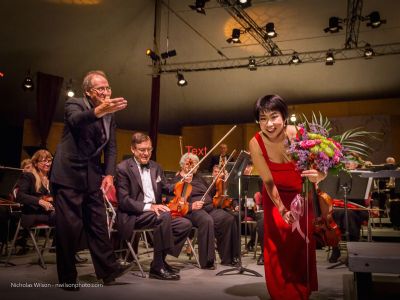|
Symphony
MYSTICAL PLANETS AND LIVELY GERSHWIN ORTIZ AT FINAL SRS CONCERT
by Peter Lert
Sunday, May 4, 2025
Symphony
VSO'S CONCERT MUSIC OF TIME, MUSIC OF PLACE
by Peter Lert
Sunday, April 27, 2025
Choral and Vocal
VOCAL ELEGANCE AND FIRE AT THE 222'S RECITAL APRIL 26
by Pamela Hicks Gailey
Saturday, April 26, 2025
CANTIAMO SONOMA SINGS AN INSPIRED GOOD FRIDAY MOZART REQUIEM CONCERT
by Pamela Hicks Gailey
Friday, April 18, 2025
DRAMATIC SHOSTAKOVICH SYMPHONY CLOSES PHILHARMONIC'S 25TH SEASON
by Terry McNeill
Sunday, April 13, 2025
LARGE COLLEGE OF MARIN AUDIENCE GREETS STOPHER ARTISTRY
by Terry McNeill
Saturday, April 5, 2025
Chamber
FRISSON DELIVERS SHIVERS OF DELIGHT
by Abby Wasserman
Sunday, March 30, 2025
OLD AND MOSTLY NEW IN SRS MARCH CONCERT IN WEILL
by Peter Lert
Saturday, March 22, 2025
Symphony
TWO FORMIDABLE SYMPHONIES AND PURPLE MOUNTAINS AT SRS CONCERT
by Peter Lert
Sunday, February 23, 2025
Chamber
THE PARKER CAPTURES DEMANDING ADES QUARTET AT RAC SEBASTOPOL CONCERT
by Peter Lert
Saturday, February 15, 2025
|
 |
 Alan Pollack Cheers Livia Sohn July 11 (Nicholas Wilson Photo) |
SPLASHY RUSSIAN MUSIC IN MENDOCINO MUSIC FESTIVAL OPENER
by Terry McNeill
Saturday, July 11, 2015
Summer music festivals season tend to be launched each season with a sparkling audience-pleasing program, and the 29th Mendocino Music Festival opening concert was no exception July 11 with an all-Russian program in the big white tent concert hall on Mendocino’s breezy bluff.
Conducted by Artistic Director Allan Pollack, Shostakovich’s Jazz Suite No. 2 was an exciting beginning, a three-movement work from the 1930s that takes raucous orchestration to its zenith. The composer is a master at this kind of music, melding into the rhythms snare drum and trombone solos with in the second movement a “palm court” saxophone part.
Mr. Pollack conducted without score and was able to easily move the music from a circus polka style of the familiar “Waltz 2” movement to a forceful quick ride march in the final “Dance 1.” Bravos from the audience ensued.
Even given the Orchestra’s dynamic playing and catchy themes, the work quickly fades from memory. Not so with the Prokofiev 7th Symphony, the composer’s last from 1952. It’s a curious work, similar to the 7th (and last) of Sibelius in its autumnal character. And there are two possible endings to the last movement, one with a mysterious fade to the bell song of the opening Moderato movement, and one with 22 additional bars of a gallop and pulsating conclusion. I’ve usually heard the former but Mr. Pollack chose the latter, and it worked well.
The noble first-movement theme in C-Sharp Minor was played majestically, the sonic balance good with shining brass contrasting with a lonely triangle part and lovely solos from clarinetist Eric Kritz. Before the lively Allegretto began a faint sound from a rock band from the nearby McCallum House Inn wedding party was heard in the tent, a casualty of how loud music can carry far at night across an ocean bluff. Some audience clapping followed this movement’s conclusion, an acknowledgment of the Thomas Nugent’s oboe playing and pungent trombone and trumpet lines.
The wistful slow Andante was deftly shaped by Mr. Pollack, the music moving through remote keys and graceful colors. Adding to this rich sonic fabric were soft harp arpeggios (Anna Maria Mendieta) and piquant triangle and xylophone playing. A fetching combination.
A lot is going on with the finale’s boisterous march, and the connection to banal parts of the preceding Jazz Suite was palpable. It’s a loud movement in places, the sound distinct through the tent’s direct (non reverb) acoustics. The conductor with his signature sweeping arm movements was able to carefully juxtapose the propulsive and often violent sections with the composer’s mellow nostalgia. It became a satisfying benediction.
Programming this Prokofiev Symphony was a brave choice for Mr. Pollack, and the results were for me the evening’s highlight.
Tchaikovsky ’s marvelous D Major violin concerto with soloist Livia Sohn completed the program. Although even more popular than the Mendelssohn, Beethoven and Brahms concertos, the Tchaikovsky has been seldom played on the North Coast, and the last time I recall it was a potent Marin Symphony performance in 2010 with Vadim Repin.
Thematic richness characterizes the Concerto from 1878, and Ms. Sohn made the most of the Allegro’s stately themes and the conductor’s choice of a slow tempo. The interpretation was not weighty and Ms. Sohn was content to emphasize lyricism, legato ascending scale passages and chaste ritards before delicately held top notes. In climaxes her sound was sporadically covered by the Orchestra, but the long cadenza was played with enough virtuosity, though limited in power, to bring most of the audience of 800 to its feet in an ovation. And it was just the first movement.
In the following Canzonetta Ms. Sohn’s control of pianissimo was assured during short duos with clarinet, oboe and flutists Mindy Rosenfelt and Kathleen Reynolds. The phrases were shaped with elegance and subtle charm.
Without pause the music drove into a lively Allegro vivicissimo, and Mr. Pollack drew from the Orchestra some of the concert’s best playing. The tempo here was brisk, but not so fast that coordination with the violinist was affected. Ms. Sohn’s light and fleet bow technique was well matched to this quintessential pyrotechnical finale, and surprisingly the low register violin sound was as persuasive as the famous splashy high notes.
Applause was long and loud, but no encore was offered.
|

